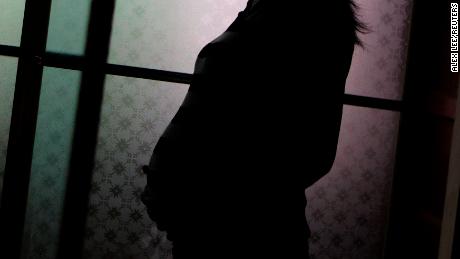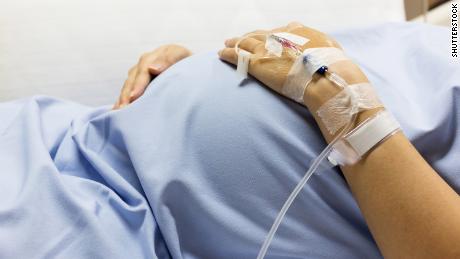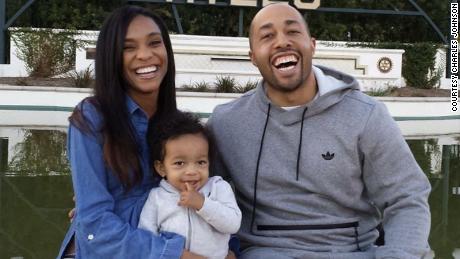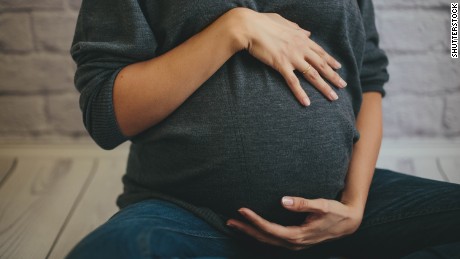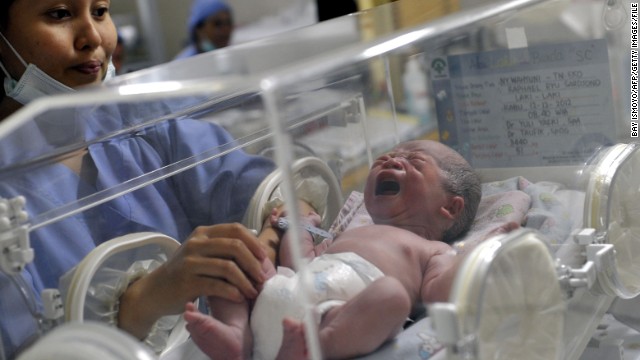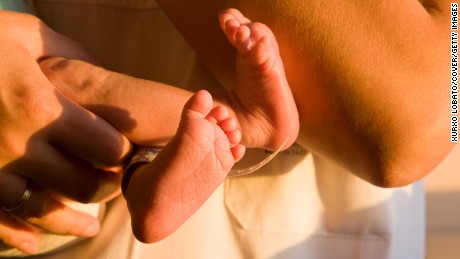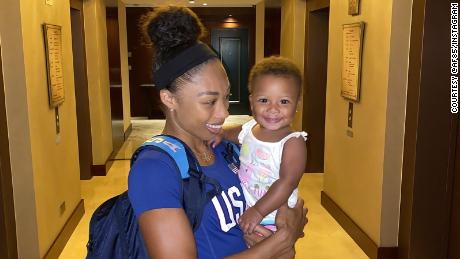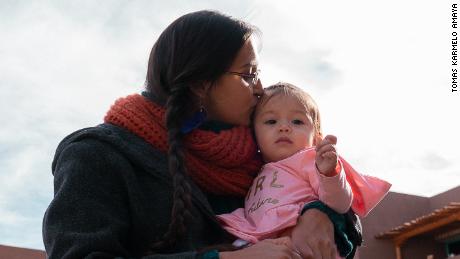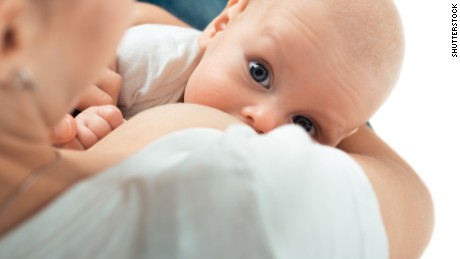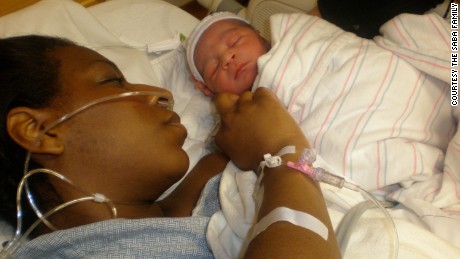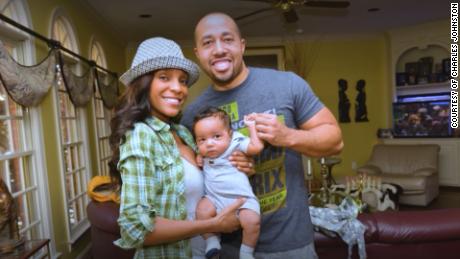The US has the highest maternal death rate of any developed nation. California is trying to do something about that
Updated 1322 GMT (2122 HKT) April 16, 2020
(CNN)Even before she became pregnant, Tatia Oden French always had a glow about her -- and people noticed.
"She walked into a room and it just kind of lit up," said her mother Maddy Oden.
When Tatia became pregnant in 2001 -- just a year after earning her Ph.D. in child psychology and marrying her husband -- that glow magnified.
The blissful newlyweds, who lived in Oakland, California, were excited about having a baby girl. They'd even chosen her name: Zorah Allie Mae French.
CNN's Jacqueline Howard reported this story as a project for the USC Annenberg Center for Health Journalism's National Fellowship.
Around that same time, "she had applied to several medical schools and it was looking like she would get into one," Oden said about her daughter. "She was super smart."
Tatia, 32, had a healthy pregnancy but at nearly two weeks past her due date, she still hadn't gone into labor. Her doctor and nurses told her it was time to induce labor, said Oden, who still lives in Oakland.
Tatia was hesitant to be induced.
"When I asked her what was wrong in terms of trying to make this decision -- because she usually didn't have problems making decisions after she considered everything -- she said that she just didn't like their attitude," Oden said, adding that she and her daughter both felt like the medical team was more focused on pushing for induction than hearing Tatia's concerns.
Still, Tatia eventually agreed, and with the soon-to-be parents at the hospital, Oden went home to get some rest before her grandbaby was born.
Around 4 a.m., Oden woke with a feeling that something was wrong.
"I was in the kitchen making coffee and my son-in-law called me and said,'You have to come to the hospital right away. They're going to do an emergency C-section,'" Oden said.
When Oden arrived at the hospital, she went to the room where she had last seen her daughter. There was no longer a bed in the room. Only her son-in-law.
"I said 'Where's Tatia?' And he said, 'She's gone.' I said, 'Gone where?' And he said, 'She's gone,'" Oden said. "Then I realized what he was talking about."
Oden learned that about 10 hours after Tatia's labor was induced, both she and her baby girl, Zorah, had died. Tatia had an amniotic fluid embolism or AFE, a rare obstetric emergency that occurs when amniotic fluid, which surrounds a baby in the uterus, or other debris enter the mother's bloodstream.
On that cold and rainy December day -- just three days after Christmas -- Tatia became one of the nearly 600 women who died due to childbirth or pregnancy in the United States in 2001.
In the years since Tatia passed away, statistics on maternal deaths, especially for black women like her, have only gotten worse.
Hundreds of US women die each year in childbirth
In 2018, the year with the most recent national data, 658 women in the United States died while pregnant or within 42 days of the end of pregnancy, according to data published in the US Centers for Disease Control and Prevention's National Vital Statistics Reports in January.
The CDC report also found that the maternal death rate among non-Hispanic black women was 37.1 deaths per 100,000 live births, a rate up to three times the rates for white and Hispanic women -- and that disparity increases with age.
These data from CDC "represent a landmark for this really important topic," saidÔÇ»Dr. Janine Clayton,ÔÇ»associate director for research on women's health and director of the Office of Research on Women's Health at the National Institutes of Health in Washington, DC.
"It gives us more evidence and more confidence that these maternal mortality rates that we're seeing in the United States -- that are still higher than those of our peer countries -- truly represent a critical public health issue and serious concern for the health of women."
The United States continues to have the highest maternal death rate of all developed countries, according to researchers.
According to the World Health Organization and other health groups, Bahrain, Japan, Kuwait, Portugal, Qatar, South Korea, Saudi Arabia, Turkey and Uruguay were estimated to have lower maternal death rates than the United States in 2017, the year with the most recent global data available.
Researchers have known that the maternal death rate in the United States has been a growing public health concern, and that about 60% of pregnancy-related deaths are preventable -- but the death rate continues to increase. And in the US, some mothers remain more at risk of death from pregnancy or childbirth complications than others -- black women.
Experts have noted that the racial disparity in maternal deaths remains even despite the mother's income and education level.
"If you're a black woman with a college education, you still have a higher mortality rate than a white woman who didn't graduate high school and I think that says so much," said Dr. Jasmine Johnson, a maternal-fetal medicine fellow at the University of North Carolina at Chapel Hill, who has treated high-risk pregnancies and studied maternal health disparities.
Researchers often point to differences in levels of stress, community health and implicit bias, including variations in the ways in which health care is delivered to black versus white women despite their income, education and health care access.
"In hearing the stories of women who have gone through pregnancy and had a bad outcome but survived, one of the underlying themes is that they voiced their concerns ... and they didn't feel listened to or they felt their concerns were dismissed," Johnson said.
"We need to own the fact that the practice of medicine is not immune to the influences of implicit and explicit bias.
"Race is not the risk factor," Johnson said. "Racism is the risk factor."
And perspectives are starting to change.
States, including California where Tatia lived, are tracking maternal deaths. Doctors are training for birth emergencies. And black women -- the ones most likely to die due to pregnancy or childbirth in the United States -- are speaking up.
Just last year, California became the first state to require hospitals and birth centers to implement implicit bias trainings for all health workers involved in perinatal care. That move followed many years of cries to save women's lives.
Could California hold clues to reducing maternal deaths?
Five years after Tatia and her baby died in a California hospital, the state formed a maternal death review committee as reports of maternal deaths emerged across the state.
Since 2006, the California Maternal Quality Care Collaborative or CMQCC, founded atÔÇ»Stanford University School of Medicine, has investigated common causes of maternal death. It then recommends policies or interventions that could help reduce them.
Between 2006 and 2013, California saw maternal mortalityÔÇ»decline by 55%, even as the national maternal mortality rate rose, according to the collaborative's website.
Recent data have shown that California has "done well" in reducing maternal death rates,ÔÇ»said Dr. Elliott Main, a professor of obstetrics and gynecology at Stanford University School of Medicine and medical director of the CMQCC.
"We are one of the few states that has actually seen a decline."
Hospitals that are members of California's collaborative used data from maternal death investigations to implement changes in their emergency care practices related to complications like hemorrhage and infections, which are among the leading causes of maternal deaths.
Hemorrhage carts were first promoted in California beginning in 2010, Main said. The carts were then promoted nationally a few years later.
"Currently over 95% of California hospitals have carts," Main said.
Hemorrhage carts are similar to crash carts used for a cardiac arrest, and are stocked with medicines to slow bleeding, instruments to repair lacerations, intrauterine balloons to apply pressure and manage bleeding from a uterus that isn't contracting normally, among other tools. Medical teams train and rehearse how to use the carts.
Kaiser Permanente, the largest private integrated health care organization in the United States, has implemented these nationally recognized safety bundles -- a set of protocols and tools to improve maternal care -- along with its own best practices to reduce the risk of maternal death in its hospitals.
For such efforts and practices to be taken nationwide, however, requires a shift in thinking, said Dr. Lawrence Lurvey, regional assistant medical director of Quality, and Women and Children's Health for Kaiser Permanente in Southern California.
"If I went back to residency -- let's say 25, 26 years ago -- there was a sense in obstetrics that bad things happen and that you couldn't do anything about it. That's absolutely not the case anymore," Lurvey said. "This work takes time and Kaiser Permanente has been at it for many years. A big integrated system such as ours has some advantages when it comes to standardization and data gathering."
Dr. Michael Fassett, a CMQCC committee member and perinatologist, remembers after the collaborative first launched, he tracked data on maternal health outcomes in his hospital, Kaiser Permanente in West Los Angeles.
"I could see as I collected data, month to month to month, that things were changing," he said. "It was pretty dramatic."
California was also one of the first states to enroll in the Alliance for Innovation on Maternal Health or AIM, a nationwide initiative to reduce maternal mortality. It launched in 2014 with the national goal to reduce maternal mortality in the United States by 1,000 cases and severe maternal morbidity by 100,000 instances over a four-year period. Maternal morbidity is any illness or condition related to pregnancy or childbirth.
As part of the initiative, AIM established tools and protocols for hospital systems and other health care settings to adopt to help prevent pregnancy- or childbirth-related emergencies. But AIM didn't reach its goal in 2018 and its work continues. The goals were originally set with the assumption that all 50 states would adopt AIM's safety bundles, said Main, a member of the original AIM team.
As of mid-December, 29 states had enrolled in the program.
"What we've also learned is that it takes time, a longer time, for the state infrastructure to be built, the data to be collected, and all of the hospitalsÔÇ»to be engagedÔÇ»to achieveÔÇ»the full impact of a quality improvement project," Main said.
'When something goes down ... people become silent'
Still, while the California numbers show some improvement, they are not cause for celebration, said Deborah Allen, deputy director of the LA County Department of Public Health's health promotion bureau.
"One of the things that you find in places like Los Angeles -- and many other parts of California -- is that where you have very advanced health care, what you may see is that women who have extreme health crises around the time of delivery don't show up as deaths because they get saved, but it still raises questions about what got them to that point of emergency," Allen said.
"Certainly averting deaths is a very positive thing, but seeing it as completely cause for celebration without looking at severe maternal morbidity around the time of birth is an important question," she said. "That's one caveat that we have to be careful that we're not just looking at our ability to save people before they bleed to death."
Additionally, the racial disparities between white and black women in both Los Angeles County and California as a whole remain.
"I don't think anyone can be too enthusiastic about what gains we've made until we confront that inequality," Allen said.
Another caveat: studying maternal deaths in general can be challenging and there can be some limitations with data collection and surveillance -- including thatÔÇ»someÔÇ»hospitals areÔÇ»hesitant toÔÇ»promptlyÔÇ»report a maternal deathÔÇ»prior to its own internal investigations, which would be needed to track deaths and their causes, said Alice Benjamin, a clinical nurse specialist based in Los Angeles
"There's not a culture in the health care community that allows us toÔÇ»freely, without stigma, be able to share and learn from each other," Benjamin said. "Even if those data are shared with the CDC and state department of health, they don't go to other peer health care providers or entities to learn. Many times non-disclosure agreements in settlements preclude the very details we need to learn from, from ever being shared."
As a black mother, Benjamin says that her hope for the future is for greater attention to be paid to women's health overall -- and for hospitals to have better reporting and surveillance systems when it comes to maternal mortality.
"Information is good, but it's only as good as what you're going to do with it and that's where I get frustrated," she said.
"What happens once you do identify cases? What are we doing internally to actually change things? Where's the bite in the bark?
"As a clinical nurse specialist, I got to see many types of the medical errors, snafus and near misses. ... And it's not uncommon when something goes down, even in the most reputable institutions, people become silent."
'Nothing went according to my plan'
One of those near misses could have been six-time Olympic gold medalist Allyson Felix. In 2018, Felix was pregnant with her first child. She stayed healthy, continued training as an elite track and field athlete, and didn't have any issues, she said.
"I was working closely with my doctor to make sure I was doing the right things," said Felix, who nowÔÇ»holds the record for the most gold medals at the track and field World Championships.
"At 32 weeks I was going in for my routine check-up and that's when the doctor wanted to do further tests. She was noticing some things that were concerning her and so she sent me over to the hospital right away to be further monitored," Felix said.
She was admitted to a hospital in California, near where she lives.
"And that's when things quickly went downhill," she said.
Doctors noticed that Felix had extremely high blood pressure and they diagnosed her with a severe case of preeclampsia, characterized by the development of high blood pressure and protein in the urine or other problems during pregnancy and other symptoms. Women with preeclampsia are at increased risk of organ damage or failure, preterm birth, pregnancy loss and stroke.
Research suggests that rates of preeclampsia and eclampsia are about 60% higher for black women than for white women. Eclampsia is diagnosed when a woman with severe preeclampsia starts to have seizures.
"It was just really scary. I had never imagined myself in that situation," Felix said. "The doctor came in and let me know it was an emergency situation and we were going to have to do an emergency C-section so that both me and Camryn could make it."
Felix's daughter Camryn was born early on that day in early December and she spent a month in the hospital's neonatal intensive care unit.
Felix said that she did not know to look for signs of preeclampsia -- which could include headaches or swelling of the hands and face -- or that being African American put her at higher risk.
"It was just this eye-opening experience that it doesn't matter how great of medical care you have or you could be of privilege and still be in this situation," Felix said. "This is a problem that women of color are facing."
Felix returned to training on the track after giving birth, but she also became a maternal health advocate.
"When I thought about starting a family and what it looked like to come back to training, I had this perfect plan in my mind. I thought everything was going to go smoothly. I thought I'd be back on the track four weeks after birth and nothing went according to my plan," Felix said.
Last May, Felix shared her birthing experience during in a congressional hearing held by the US House Ways and Means Committee on Capitol Hill. She urged lawmakers to take national action to address the racial disparities seen in the maternal mortality crisis.
Since then, there's been a step in the right direction, she said, referring to the California bill requiring perinatal health care providers undergo implicit bias training.
"I would love to see more of that across the country," Felix said.
It may be starting.
In March, a group of lawmakers -- led by Illinois Rep. Lauren Underwood, North Carolina Rep. Alma Adams and California Sen. Kamala Harris -- introduced bipartisan legislation in Congress aimed at reducing the maternal death rate in the United States.
The measure, called the Black Maternal Health Momnibus, is composed of nine bills, some of which support "a 12-month postpartum Medicaid coverage expansion, investing in rural maternal health, increasing the diversity of the perinatal workforce -- so that would be your physicians, midwives, doulas -- and implementing implicit bias training," Underwood said. "We have until the end of the calendar year to do this work in the 116th Congress."
Doulas as a solution
Outside of what's happening in hospitals and in legislatures, midwives and doulas have moved to empower women in childbirth, even if resources remain scarce. Doulas differ from midwives in that while they provide support and comfort during delivery, they do not provide medical advice nor can they change the clinical recommendations of a midwife or an obstetrician. But they often can help identify any concerns or problems the mother might experience.
Some experts point to doula care as being one way to reduce the racial disparities seen in maternal health -- and such action has been taken on the county-level in California.
Last year, Los Angeles County launched a program specifically to provide doula care services to black women in an effort to address and reduce racial disparities seen in maternal health. The program is part of the county's broad African American Infant and Maternal Mortality prevention initiative.
The LA County Department of Public Health received $1 million in funding from the state to launch the two-year pilot program, which provides doula services to black women at no cost. The services include prenatal visits, postpartum visits and continuous doula support during labor and delivery.
Mothers with support from doulas are four times less likely to have a baby with low birth weight, two times less likely to experience a birth complication and significantly more likely to initiate breastfeeding after birth, according to a study published in the Journal of Perinatal Education in 2013.
Black patients are often prescribed less pain medication than white patients, several studies suggest. Whereas, doula support during childbirth can help reduce levels of discomfort for the mother as a doula might suggest practices during labor to ward off pain.
In Los Angeles, "our goal is to serve African American women and families with birth doula services, provided by African American doulas. We now have a team of 12 doulas," said Helen O'Connor, health program analyst for the LA County Department of Public Health.
She added that the program's success will be measured by whether the program is associated with a reduction in preterm birth and C-section rates among women and the use of certain interventions in hospitals that could signal there was a maternal health problem.
The program has a focus on specific communities in the county: South Los Angeles, the South Bay, Antelope Valley and San Gabriel Valley.
"Usually theÔÇ»onlyÔÇ»women who get doula care are women whoÔÇ»canÔÇ»pay for it," said Allen of the LA County Department of Public Health.
"We're both trying to increase the workforce of African American doulas and provide subsidy for African American doulas we contract with to serve women in the black community," she said.
Allen added that "there is no biological reason" for black women to die more often than white women in pregnancy or childbirth.
"There is a combination of factors at work there, all of which speak ultimately to social inequality," she said. "There's a particular message for black women and that's don't bear the burden yourself. If you've had an adverse birth outcome, don't assume it's your fault. Recognize that in a society with inequality, you are subject to stress and that you need support for that stress."
A mother mourns -- and takes action
After Tatia Oden French's death during childbirth in 2001, her mother, Maddy Oden, began to research more about maternal deaths. She learned that some research suggests that a medically induced labor can be associated with an increased risk of AFE, the rare condition that took her daughter's life.
Oden launched the Tatia Oden French Memorial Foundation in 2003 to raise awareness around maternal health risks.
"Women of color specifically, and definitely in labor and delivery, are treated much different than white women, and the reason is that a lot of people in the medical profession are culturally incompetent," Oden said. "They have this idea that people of color, African American women, can withstand more pain than white women."
Oden petitioned the US Food and Drug Administration to restrict the use of the drug misoprostol in labor inductions -- the drug used to induce Tatia's labor. The medication, intended to prevent or treat ulcers, has not been FDA approved for labor and delivery purposes but is still commonly used to induce labor in the United States.
Since the drug was never intended for labor induction, any use of it for that purpose would be off label. There is no law against the "off-label" use of a drug in the United States. The practice refers to when a healthcare provider prescribes a FDA-approved drug for an unapproved use because they judge it can be helpful for their patient, even though the FDA has not determined that drug is safe and effective for the unapproved use. The drug misoprostol has a warning label that states uterine rupture and other risks have been associated with that off-label use.
Get CNN Health's weekly newsletter
Sign up here to get The Results Are In with Dr. Sanjay Gupta every Tuesday from the CNN Health team.
In the early 2000s, the FDA first published an alert regarding the risks of using the drug for inducing labor. Then in 2015, an updated alert was published on its website.
It notes that while pregnant women may be offered misoprostol to induce labor or decrease blood loss after childbirth, "these uses are not approved by the FDA. No company has sent the FDA scientific proof that misoprostol is safe and effective for these uses."
Oden has continued to advocate for ways to improve black maternal health -- something that she has dedicated her life to after losing Tatia. She wanted to help women make fully informed decisions regarding the births of their children. She wanted to prevent maternal deaths from touching other families. She wanted it so much she studied and began a new career in health, like her daughter might have done.
Oden became a doula.
